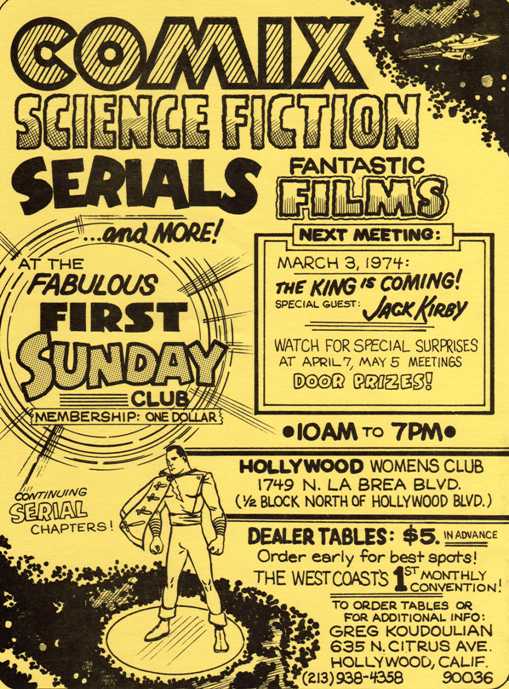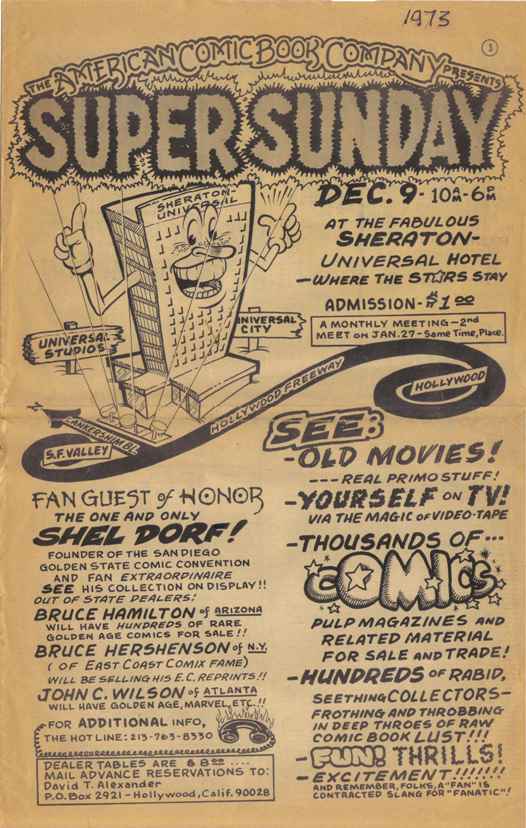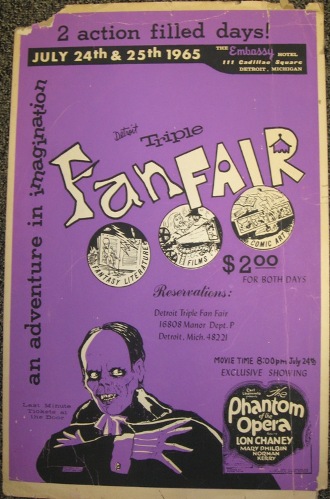[Editor’s Note: The following is the inaugural guest post for the Comic-Convention Memories web site. That it is by Mark Evanier seems appropriate since, if I were asked to name someone who could be called “Mr. Comic Convention,” “Mark Evanier” would be the first name to pop into my mind, and I’m guessing that I’m not alone in that. Mark was a friend to Comic-Con International from before the first con was held, as he has been a friend to so many other comic conventions.]
Inside Comics #2, August 1974 (published by Galaxy News Service) featured a Mark Evanier article titled “The Mini-Cons That Attacked Southern California!” Now, freshly discovered in the the Greg Koudoulian archives, it is hereby reprinted with the author’s permission.
The Mini-Cons That Attacked Southern California!
by Mark Evanier
(From Inside Comics #2, August 1974)
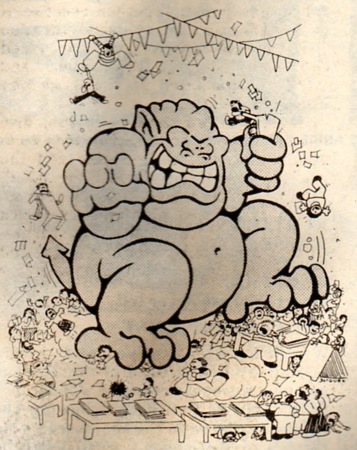
They’ve come in droves! Dozens of them! “Super Sundays,” “First Sundays” and “King Cons!” Never-ending, never-ceasing, coming week after week after week. And, like any fad that has taken hold in Southern California, the fans love it!
Predicated on the notion that bigger is not necessarily better, the trend is to the mini-convention—one day events, two days at most. Sure, the new think goes, big conventions are great, hut they’re not without their drawbacks. Drawbacks brought on by their often unwieldy length.
At three- or four-day conventions—or even a five-day blockbuster like 1973’s New York Comic Art Convention—the closing days can became an endurance contest, not just of finances, but also of physical survival. No fan worth his weight in price guides will get any notable amount of shut-eye at a convention and by the last day, the whole affair seems to have slowed from 45 rpm to 33⅓. There is also something distinctly pathetic about watching the dealers room slowly disintegrate as the convention heads to its inevitable conclusion.
But, at these quickly proliferating one-day conventions, there is no need for sleeping, thus saving already precarious fannish health—not to mention lowering omnipresent hotel costs. The smaller convention can go the distance without slackening the pace, and there is ample time to survey the dealers room and every outrageously priced nook and outlandishly priced cranny therein.
“When I get to a big convention,” said one attendee of a recent one-day fanclave, “I make a quick sweep of the dealers room to snatch up any obvious bargains. Then, I usually don’t do much buying until the last day—just before I’m going to leave and some prices may have gone down. Cons like this one compress a whole three-day con into one afternoon. I buy just as much and the prices have been better.”
Other enthusiasts of one-day conventions are saying things like “This is the future of cons,” and “I’ve never gotten such bargains!”
Greg Koudoulian, who founded and runs the First Sunday Club, explained the how and why of the new-found bargain prices: “A lot of dealers we get aren’t dealers. They’re just fans with stuff to sell. But they don’t want to shell out 50 bucks for a table at a big con and then have to sit behind it for four, five days to unload their stock. The overhead is less.”
Koudoulian charges $5 for a table at his one-day meetings. This remains a rather sane alternative to the $60 charge being asked for the upcoming, six-day San Diego Convention. At the $60 rate, no dealer can afford to bother with nickel-and-dime bargain comics. But, when paying only the $5 charge for exhibition space, there is no pressure on the huckster to pad prices to recoup his table fee.
“Everybody makes back the cost of the table in his first hour or so,” Koudoulian said recently.
Koudoulian’s First Sunday Club was the first series of mini-conventions in recent Southern California fan history. Once a popular event, especially in Los Angeles, the mini-cons died out and no one took the necessary initiative to revive them until Koudoulian stepped in late in 1973.
“I heard about the Second Sunday cons in New York,” Koudoulian said at a recent convention, “and about the other cons in other cities. And everyone knew that Los Angeles should have something like that. The business of buying old comics started in L.A.”
So on November 4, 1973, the First Sunday Club held its first monthly meeting at the Hollywood Woman’s Club, just a few blocks from Hollywood Boulevard and the Chinese Theater. Some 30 dealers and several hundred fans turned out for the pioneer gathering, most encouraged by the paltry $1 admission charge. Since that first meeting, attendance and demand for dealer space has swelled and Koudoulian has moved his operation to the plush Americana Hotel in Culver City.
At the First Sunday Club’s last Hollywood assembly on March 3rd, special guest Jack Kirby helped draw a record attendance. Ray Bradbury put in an unscheduled appearance at that last First Sunday meet in the Woman’s Club and stayed for an hour. Bradbury, who doesn’t drive, left his taxi ticking away in the parking lot. That’s class! Or a terrible comment about taxi service in L.A.
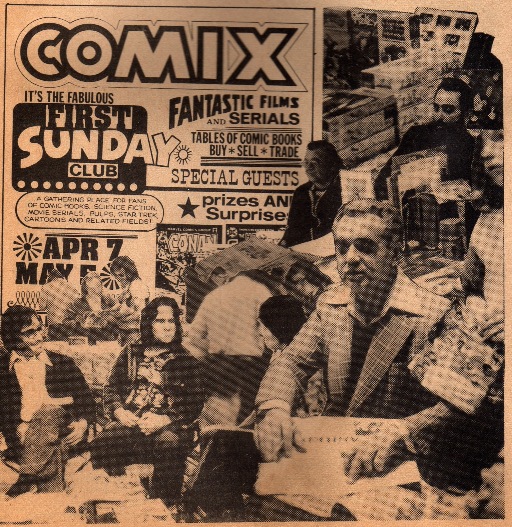
Among the montage of mini-con mayhem is Jack Kirby (bottom right), Shel Dorf (behind and to the left of Kirby) and Greg Koudoulian (bottom, second from left).
It was inevitable that Koudoulian’s success spawn imitators, and it wasn’t long before other similar mini-cons began sprouting. Shortly after Koudoulian began his group, two local comic dealers announced plans for a “Super Sunday” convention at intermittent intervals. David Alexander and Terry Stroud, who run the American Comic Book Club, secured the Sheraton-Universal Hotel for their meetings. (The Sheraton Universal had previously become nationally famous due to the negative notoriety Johnny Carson has heaped on it—he’s called it “The Sheraton-Unusual.” among other things.) The facilities are quite nice and no one has yet complained about the socio-political implications of patronizing an ITT affiliate.
Like the First Sunday Club, the Alexander/Stroud function charges $1 for admission, but dealers tables are $10 as opposed to Koudoulian’s $5 charge. Regardless, the hucksters turn out in full force and the Super Sunday dealers room is often better stocked than most larger conventions. Like Koudoulian’s group, the Second Sunday gatherings offer films—usually a program of movie serial chapters, cartoons, comedy shorts and science fiction flicks.
Unlike First Sunday Club meetings, however, the Super Sundays usually shun the notion of formally-announced special guests. Not to say they didn’t try it, though.
In promoting their meeting for this past February 10th, the American Comic Book people advertised the attendance of Alex Toth and Geri Glass, PLAYBOY’s gatefold girl for the previous September.
“Geri has never attended a comic book convention and she tells us she is excited about seeing the many rare items on display,” was the way one promotion flyer read. “She will be at the American Comic Book Company’s tables selling the most valuable golden age comics and signing autographs for her many fans.”
After that (Super) Sunday was over, Miss September still hadn’t been to a comic convention … she didn’t make the gathering. Nor did Alex’ Toth. Luckily, Russell Myers, Sergio Aragones, Mike Royer, Walter Koenig and Harlan Ellison did drop by unannounced. None of them were as pretty as Glass, admittedly, but they all drew, wrote or acted better. And they were all fully clad, for better or worse.
This past February was a hectic one for comic fans in any event. The first Sunday of the month brought—you were expecting maybe Hugh Hefner—the First Sunday Club. The second Sunday was set aside for the Glass-less Super Sunday at the Sheraton-Universal.
And on the third weekend of the month there came the King Kon in San Diego—a two-day mini-convention under the auspices of Shel Dorf and Ken Krueger, who are among the directors of the annual San Diego Convention. Admission for the two-day King Kon was $2 in advance or $4 at the door, but table space ran considerably higher: $20 in advance or $25 at the door. Whereas both the First Sunday gatherings and Super Sunday meetings had been considered unqualified successes, King Kon was met with only mixed reactions.
San Diego, being only 126 miles from Los Angeles, has always relied heavily on commuting fans to support their fannish endeavors. Whether because of the gas shortage or the over-saturation of similar conventions, King Kon ended with many dealers disgruntled and audibly disappointed at the sales and general turn-out.
King Kon, two days in length, also seemed to strike an unsatisfactory compromise between the one-day and the full-scale convention. It had the disadvantages of both cons and the advantages of neither. All-night movies were a significant feature of the convention— but that would only force any interested fans and dealers to spend money for hotel rooms. And if that wasn’t bad enough, anyone so inclined had to make his own arrangements—the convention staff had neglected to secure a hotel.
But while most attendees chose not to stay on for the movie showing, Dorf said the program was quite successful—catering to the San Diego audience.
“They really went for the films,” Dorf explained while manning his table at the following First Sunday gathering. “I found myself running the projector at six in the morning for a group of people who were enjoying every minute. An awful lot of them had never been to a con before.”
And Dorf s remarks rang true. Most of the First Sunday Club’s attendees seemed like novices to the world of fandom and conventions, possibly comic books readers who had previously been frightened away by large, imposing conventions.
Nevertheless, Dorf is hoping to continue the King Kon series, possibly in a modified format. In addition, he is planning for the forthcoming six-day San Diego Convention which will run from July 31st through August 5th.
Many local fans who have become accustomed to the rash of mini-cons are now horrified at the notion of six consecutive days of conventioning. One of them, scanning the impressive lists of guests and special features at the upcoming San Diego conclave, gasped in a Graham Ingels manner; after mentally tabulating the equally mammoth hotel tab, he gasped again … louder.
Perhaps the upcoming San Diego fanfare seems extreme in light of the recent rediscovery of the one-day affair, which has reoriented fandom into smaller groupings. The $60 table rate will no doubt rule out the smaller dealers and once again bring on the curse of blatant commercialism that has been so rampant at recent large conventions. It will no doubt be a fine convention, but it will lack the quiet intimacy the short conventions have reintroduced to Southern California fandom.
The six-day convention in San Diego— and the impending Independence Day New York Convention—notwithstanding, the one-day convention may well be the wave of the future. They are already in evidence in other cities. Seuling’s Second Sunday has given way to the monthly Comic Book Marketplace and a half-dozen other cities hold regularly scheduled gatherings. In England, the large convention has never been all that popular, and the convention scene consists strictly of one-day affairs.
This past March 21st Graceland College in Lamoni, Iowa hosted the Lamoni-Con—Lamoni being 79 miles south of Des Moines, as the crow flies.
And if Lamoni, Iowa—population 2,502—can host a convention, is the outbreak of small, regional gatherings far in the future? If these mini-cons are the shape of things to come, it may be a reaffirmation of the fellowship of fandom—a fellowship which often seems to be rapidly evaporating at the hands of those monstrously long and impersonal super-conventions.
